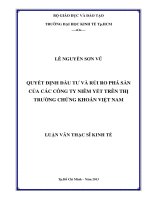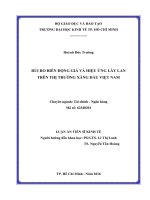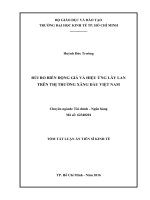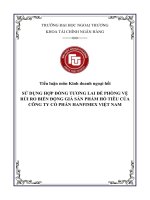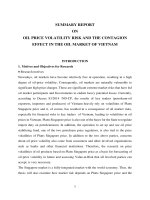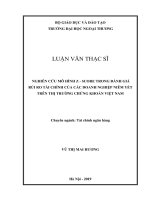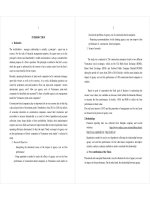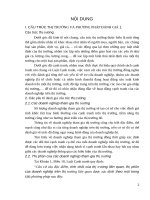RỦI RO BIẾN ĐỘNG GIÁ và HIỆU ỨNG lây LAN TRÊN THỊ TRƯỜNG XĂNG dầu VIỆT NAM (tt)
Bạn đang xem bản rút gọn của tài liệu. Xem và tải ngay bản đầy đủ của tài liệu tại đây (543.46 KB, 29 trang )
SUMMARY REPORT
ON
OIL PRICE VOLATILITY RISK AND THE CONTAGION
EFFECT IN THE OIL MARKET OF VIETNAM
INTRODUCTION
1. Motives and Objectives for Research
♦ Research motives
Nowadays, oil markets have become relatively free in operation, resulting in a high
degree of oil-price volatility; Consequently, oil markets are naturally vulnerable to
significant high price changes. Those are significant extreme market risks that have led
oil market participants and Governments to endure heavy potential losses. Currently,
according to Decree 83/2014 /NĐ-CP, the results of key traders (petroleum-oil
exporters, importers and producers) of Vietnam heavily rely on volatilities of Platts
Singapore price and it, of course, has resulted in a consequence of oil market risks,
especially for financial risks to key traders of Vietnam, leading to volatilities in oil
prices in Vietnam. Platts Singapore price is also one of the bases for the State to regulate
import duty on petroleumeum. In addition, the operation to set up and use oil price
stabilizing fund, one of the two petroleum price regulators, is also tied to the price
volatilities of Platts Singapore price. In addition to the two above parties, concerns
about oil price volatility also come from consumers and other involved organizations
such as banks and other financial institutions. Therefore, the research on price
volatilities of oil products based on Platts Singapore price as a basis for forecasting of
oil price volatility in future and assessing Value-at-Risk that all involved parties can
accept, is very necessary.
The Singapore market is a fully-integrated market with the world economy. Thus, the
thesis will also examine how market risk depends on Platts Singapore price and the
1
world's crude oil (WTI and Brent) prices; between Platts Singapore price and Vietnam
stock market.
Until now, in the world, there are many studies that mention the risks of the oil market
that have been discussed with a many topics under qualitative perspective. At the same
time, other studies from the quantitative perspective, especially after the 2007-2008
global financial crisis, on the risks and the measurement of the oil market risk and
forecasting of oil price volatilities have been robust over the past decade (Agnolucci,
2009; Aghayev and Rizvanoughlu, 2014). However, for Vietnam, with the exception of
a few studies in qualitative perspective, not many research on the above issues from the
quantitative perspective have been done.
To measure market risk, application of the Value-at-Risk (VaR) methodology offers
comprehensive and brief advantages (Jorion, 2007, James, 2003).
In addition, to assess the dependence structure of financial markets in general, the oil
market in particular, analysts are particularly interested in risk contagion effects (Forbes
and Rigobon, 2002; Reboredo, 2011) by using the Copula estimation method
(Embrechts et al., 1999; Grégoire et al., 2008) for testing.
♦ Studies Objective
There are numerous methods to calculate the VaR and each of them is usually linked
with certain assumptions. A good estimation method is to satisfy the actual conditions
of the market. The oil market is characterized by high volatility and continuous-time
mechanism, distribution of the return series have a fat tail distribution; the oil market is
of the general nature as other markets have different psychological reactions when crude
oil price returns rise and returns slump (Zakoian, 1994; Fan et al., 2008). Thus, from a
practical perspective and empirical study documents show with two evaluation criteria:
forecasting accuracy and reasonable loss function (Abad and Benito, 2013), VaR
estimation has been carried out using GARCH - type models, based on the Generalized
Error Distribution (GED) which can catch the volatility characteristics of the oil market.
Therefore, the thesis raises the issue of research: “Oil price volatility risk and the
contagion effect in the oil market of Vietnam” with the expectation that the research
results of the project will help petroleum-oil key traders, Government, and anyone needs
2
to assess and forecast risk in the Vietnam's oil market based on Platts Singapore
assessment.
The thesis will carry out the following research objectives:
i)
Measuring the volatility of petroleum price in Vietnam based on Platts
Singapore price using GED-TGARCH-based VaR approach.
ii)
Testing contagion effects among WTI, Brent and Platts Singapore markets;
and between Platts Singapore market and the Vietnam stock market.
iii)
Suggest implications for applying to the practice of risk management of
petroleum price in Vietnam.
2. Studies method
The research methodology is mainly quantitative applied in financial sector to clarify
research issues. At the same time, the thesis also uses qualitative methods through the
use of analytical and synthetic methods of reasoning and practical issues to make
suggestions for practical application of research results. Specifically, the research
methods is used as follows:
- Using parameter estimation method of the TGARCH model with the Generalized
Error Distribution (GED) before and after the structural breaks in the VaR estimation
to measure the petroleum price volatility in Vietnam based on Platts Singapore price.
- Use MGARCH and Copula models to test contagion effects among WTI, Brent and
Platts Singapore markets; and between Platts Singapore market and the Vietnamese
stock market
- Based on the results of quantitative analysis of the above models, the dissertation has
used the qualitative method to analyze and synthesize in order to make suggestions on
the practical implementation of petroleum price risk management in Vietnam.
3. Studies scope
Data is collected from Platts Singapore price by the daily spot price of finished oil
products such as: RON 92 petroleum; Naphtha petroleum; DO 0,05; FO180; and crude
oil prices on the WTI and Brent markets; and VN-Index.
4. The scientific and practical significance of the topic
Scientific significance
3
-
The topic has systematized studies of risk and uncertainty, the comprehensive
new awarenesses of risks, of the Value-at-Risk (VaR) in the world after the
2007-2008 global financial crisis.
-
The topic has proposed to measure the risk of oil price volatilities in Vietnam
oil market based on Platts Singapore price using GED-TGARCH-based VaR
approach
-
At the same time, the topic has proposed to apply Copula method to analyze
contagion effects among the oil markets and the oil market with the stock
market.
Practical significance
The dissertation has contributed new points of awareness, assessment and
proposing solutions to manage risks of oil business in line with Vietnam's
realities as follows:
-
For the first time the VaR Model is used to measure risk in Vietnam oil
market based on Platts Singapore price using GED-TGARCH-based VaR
approach
-
For the first time GED-TGARCH model with structural breaks is used to
calculate VaR in the Vietnam oil market based on Platts Singapore price
using Bai and Perron (2003) testing;
-
For the first time the Copula model is used to analyze contagion effects
among the WTI, Brent and Platts Singapore markets; and between the oil
market based on Platts Singapore price and the Vietnam stock market;
-
From the results of the research models, the thesis has provided practical
suggestions for key oil traders, the Government and anyone needs to assess
and forecast risk in Vietnam's oil market based on Platts Singapore price.
5. Structural thesis
In addition to the introduction, conclusion, commitment of the author, appendices,
references, the content of the thesis is structured in 4 chapters.
4
CHAPTER 1: THEORETICAL FRAMEWORK OF RISKS AND
MEASUREMENT OF OIL PRICE RISK
1.1 Theoretical Framework of Risks
1.1.1 Risk and uncertainty
The topic of risk has been raised since ancient times, from the time of the ancient
Babylonians, 3,200 BC. The history of human development also demonstrates that,
without people daring to welcome risks, society will find it difficult to make progress.
Academic researchers have different views on how to define risk and measure risk.
From a modern financial perspective, two risky approaches have developed throughout
the twentieth century. Those are the traditional financial perspective and behavioral
financial perspective. From a traditional financial standpoint, represented by Knight,
the risk is a measurable uncertainty or a presence of risk when future events occur with
measurable probability.
Behavioral finance perspective argues that risk in addition to being linked to an
objective and quantifiable factors, is also linked to subjective and qualitative factors.
Both uncertainty and risk implies suspicion and ambiguity about the outcome of an
event, but there are different reasons. Knight defines risk as imperfect knowledge where
probabilities of occurrence can be known, the uncertainty exists when the probabilities
are unknown. According to Knight, risk involved in objective probabilities; uncertainty
involved in subjective probability. It is possible to generalize the risks and uncertainties
of current views and perceptions.
Risk and uncertainty both related to the same underlying concept, that’s a randomness.
Both risks and uncertainties have the following similarities: (i) Rely on current
uncertainties regarding reality, event, outcome, or underlying scenario ...; (ii)
Determined by probability or probability distribution; (iii) Include the potential to
increase or decrease (increase or decrease prices); (iv) Subjectivity: Both depend on
who knows what.
In addition to the similarities, both risks and uncertainties are fundamentally different:
(i) Unlike uncertainty, risks include losses due to impact: potential consequences of the
5
issue to a subject/object; (ii) Risk is therefore more subjective: depending on the
potential consequences of the issue to whom.
Classification of uncertainty: There are many ways to classify uncertainty for different
purposes and for different researchers. From a financial viewpoint, the classification of
the following researchers may be considered as follows:
According to Giovanni Dosi and Massimo Egidi (1991), there are two types of
uncertainty: substantive uncertainty and procedural uncertainty. According to David
Dequech (2011) the uncertainty is divided into three groups: (i) The first distinction,
consisting of two types: substantive uncertainty and procedural uncertainty; (ii) The
second distinction, consisting of two types: weak uncertainty and strong uncertainty;
(iii) The third distinction, consisting of two types: ambiguity uncertainty and
fundamental uncertainty.
Black Swan Events:
The term Black Swan, created by Nassim Nicholas Taleb, addresses an unlikely event
with three principal characteristics: First, it is an outlier and an unpredictable, as it lies
outside the realm of regular expectations, because nothing in the past can convincingly
point to its possibility. Second, it carries a massive impact and extreme effect. Third,
after the fact, we concoct an explanation that makes it appear less random, and more
predictable, than it was.
Risk and Financial Risks Classification: Based on different criteria, it can be
categorized as: pure risks and speculative risks; systematic risk and non-systematic risk;
and business risk and financial risk.
Business risk: The risk is related to the nature of the business and production activities.
The risks of a business nature are due to factors such as the business cycle, price
volatility, price instability, competition, investment over time. Business risk is a
systematic risk, as the risk can not be diversified, unless the business risk arises from
specific business decisions (where to buy and which currency to use in international
trade…) can be diversified or can be avoided.
Financial risks: including risk is related to the companies employ financial leverage
and financial distress risk. Financial distress risk is the risk that comes from market
price factors affecting corporate outcomes. Risk management professionals often use
6
the concept of financial risk to address both types of risk when there is no need to
separately emphasize the financial distress risk. Financial risk (in the sense of financial
distress risk) includes exchange rate risk, interest rate risk, commodity price risk, stock
price risk. With the inclusion of these four types of risk, many financial risk researchers
are understood as market risk.
1.1.2 Financial risk management
According to Phillipe Jorion, financial risk management is the process by which
financial risks are identified, assessed, measured, and managed in order to create
economic value. In centralized risk management tools such as Value-at-Risk (VaR) has
emerged as a tool of particular importance in the early 1990s.
The emergence of risk management in general and financial risk management in
particular as a discipline is explained by several factors. The first factor is the massive
increase of securities and foreign exchange trading since the late 1960s. The second
factor is this growth in trading activity has taken place against an environment that was
often very volatile. The volatility of the economic environment is reflected in four
various ways: (i) stock market volatility; (ii) exchange rate volatility; (iii) interest-rate
volatility; (iv) commodity market volatility. The third factor is the development of risk
management has also been spurred on by concerns with the dangers of improper
derivatives use. The fourth factor is that the development of risk management was the
rapid advance in the state of information technology.
1.2 Measurement of oil price risk
1.2.1 Overview of the formation of oil prices
A market is a group of buyers and sellers of a particular good or service. The buyers as
a group determine the demand for the product, and the sellers as a group determine the
supply of the product (Mankiw, 2012).
On the market, supply and demand interact with each other and their interaction will
lead to the formation of market prices. Price volatilities are due to changes from supply
or demand or from both of them.. This volatility causes the price of goods in the market
to change, which may have two-way impact on the producer or the consumer.
7
When supply and demand are combined, they will affect the selling price and volume
of a particular commodity in the market. The intersection of the supply curve and the
demand curve determines the equilibrium of the market. At the equilibrium price,
demand equals supply. The behavior of buyers and sellers orients the market to
equilibrium in a natural way. When the market price is higher than the equilibrium price,
there will be a surplus of goods, causing the market price to fall. Conversely, when the
market price is below the equilibrium price, there will be a shortage of goods, which
will increase market prices. In a market economy, prices are the signal that drives
economic decisions and therefore allocates scarce resources. For commodities in the
economy, prices ensure a balance between supply and demand.
Currently, the oil market is a deregulated market due to the limited role of OPEC as the
volume only accounts for about 30% of global trading volume. The world's oil market
is seen as a perfectly competitive market that consists of two component markets: the
physical product market and the derivatives market. Derivatives market has a greater
impact on the formation of oil prices.
1.2.2 Risk of oil price volatility
Oil price shocks (that is, sudden change) can be transmitted to the macro economy via
different channels. Within the economy, a positive oil price shock (increase) will
increase the cost of production and thus limit output. This increase will, at least in part,
affect the consumer. Moreover, as gasoline prices rise, households face higher living
costs. These effects can continue to have significant price appreciation effects and affect
the entire economy, affecting macroeconomic indicators such as employment, trade
balance, inflation and public accounts. As well as stock market prices and exchange
rates.. Thereby, the nature and extent of such appreciation effects depend on the
structural characteristics of the economy. For example, the more a country engages in
oil trade, the more it is likely to face price shock on the global commodity market.
1.2.3 Risk measurement and measurement of oil price risk
Risk Metrics (VaR):
Includes methods such as gap analysis, duration analysis, scenario analysis, portfolio
theory, derivatives risk measurement, and volatility analysis.
8
Value-at-Risk (VaR) - Risk measurement standard
Value at Risk, or VaR, is a dollar measure of the minimum loss that would be expected
over a period of time with a given probability. During the 1990s, risk values were
widely recognized for measuring market risk. Since the early 1990s, non-bank energy
traders and end users (such as airlines, carriers ...) have used VaR in risk management
practices. finance. Up to now, most major oil companies and major oil traders in the
world has kept on using VaR for risk measurement (James, 2003; Burger et al., 2014).
1.3 Contagion and contagion effects
1.3.1 Overview of contagion and contagion effects
There is no consensus on the definition of contagion in finance and the method of
identifying the contagion. Since its inception, it has generated controversy throughout
the years. According to Forbes and Rigobon (2002), contagion is a signification increase
in cross-market linkages after a shock to one country (or group of countries). These two
authors also suggest the distinction between interdependence and the contagion.
Although there is a lot of debate, there seems to be a broadly-accepted view to
understanding of financial contagion in a comprehensive and complete way, a key to
understanding of financial contagion is to have access to all three key contents. These
are: (i) Notion of correlation with the expression is a sudden increase in correlation
consisting of two conditions: volatilities heightened in correlation and dependence
linkages; (ii) Channels of contagion or transmission mechanisms such as trade link
between two countries; (iii) The methods for identifying contagion manifests as the
transmission speed of rapid or slow contagion (Kolb, 2011).
According to Beirne et al. (2008), and Masson (1998), the contagion can be divided into
two types, contagion and spillover. In addition, when dealing with the contagion of
economists, other terms such as interdependence, comovement, and dependence
structure are mentioned.
Contagions in finance affect the behavior of the four actors - Governments, financial
institutions, investors and borrowers.
9
The contagion effect explains the contagion capability of the economic crisis or the
boom across countries or regions. This phenomenon can happen both at the domestic
level as well as at the global level.
1.3.2 Contagion Channels
According to Dornbusch et al (2000) and Kolb (2011), there are two possible causes for
contagion, including macroeconomic fundamentals and investors’ behavior. These
causes are transmitted through the contagion channels. The causes belong to the
macroeconomic fundamentals of transmission contagion through the following
channels: (i) Trade links; (ii) Financial links/ financial ties; (iii) Competitive
devaluation. The contagion effect depends on the behavior of investors on four issues:
(i) Liquidity and incentives problems; (ii) Information asymmetries and cooperation
problems; (iii) Multiple equilibriums; (iv) Changes in the rules of the game (changes in
the international financial system).
1.3.3 Measurement of Financial contagion
To identify the financial contagion, the researchers conducted the measurement of
contagion. Measurement of contagion can be made by observing real-life contagion and
can be identified by economic data. Leaders who are responsible for responding to
financial chaos do not have any difficulty identifying the onset stages of the contagion.
However, sometimes they do not notice until the impact is contagion. For other
economists, awareness contagion by economic data through econometric models is
sufficiently reliable. Econometric models have had a phenomenal evolution in the
cognitive process of contagion.
1.4 Empirical evidence from previous research
1.4.1 Evidence of the use of VaR in the measurement of oil price risk
The methodology developed initially for calculating portfolio VaR is (i) Parameter
method; (ii) Non-parametric method and (iii) Semiparametric method. Each of these
methodologies has different ways of calculating VaR.
Nonparametric studies on the oil market, with some authors such as Cabedo and Moya
(2003), Sadeghi and Shavalponr (2006), Fan and Jiao (2006), Sadorsky (2006).
10
Semiparametric studies on the oil market, with some interesting authors such as Feng
et al. (2004), Costello et al. (2008), Marimoutou et al. (2009).
Abad and Benito (2013) conducted a detailed comparison of VaR estimation methods
based on two criteria: Forecasting accuracy; and reasonable loss function. The authors
conclude that the parameter model can obtain a successful VaR if the conditional
variance is correctly estimated.
In terms of parametric methods, Engle (1982) proposed Autoregressive conditional
heteroskedasticity (ARCH., Bollerslev (1986) and Taylor (1986) extended by
supplementing the general ARCH model (GARCH models include, among others,
prominent oil markets such as Giot and Laurent (2003), Hung et al. (2008), Fan et al.
(2008), Agnolucci Kang et al. (2009), Agnolucci (2009), Aloui and Mabrouk (2010),
Musaddiq (2012), Aghayev and Rizvanoghlu (2014).
1.4.2 Experimental evidence of the contagion effect on the oil market
Fobes and Rigobon (2002) have determined the conditions for measuring the contagion
arising. Firstly, the contagion occurs when a shock is transmitted from one market to
another through a cross link. Secondly, that cross-linkage must be associated with a
significant increase in cross-correlation between the pre-crisis and crisis periods;
moreover, from this condition raised, the problem is to determine the right time of the
crisis. According to Rodriguez (2007), in the late 1990s, studies on contagion in the
meaning of Forbes and Rigobon (2002) are far from reaching agreement on the true
existence of the contagion. Some authors have begun to acknowledge the need to pass
linear methods to describe the contagion. Some authors have applied Copula theory to
their studies. Concerns about Copula research include authors such as Alexander
(2008); Genest and Favre (2007); Rodrignez (2007); Reboredo (2011); Wu and Liang
(2011); Wu et al. (2012); Xiaoquian et al. (2012); Aloui et al. (2013); Sukcharoen et al.
(2014); Truchis & Keddad (2014).
1.4.3 Research in Vietnam
At present, research on organization and state management of oil business is mainly
through qualitative research (Vo Tan Phong, 2000, Nguyen Duyen Cuong, 2010, Tran
11
Hiep Thuong, 2009). A survey on identifying and evaluating the use of derivative to
hedge financial risks has Nguyen Thi Ngoc Trang (2007).
In terms of risk qualification, the VaR model has some typical authors such as Tran
Trong Nguyen (2012), Hoang Duc Manh (2014) ... . However, no experimental studies
have applied VaR to measure the risk in the oil market.
In terms of Copula, there are some empirical studies in applying copula in financial risk
measurement, such as Tran Trong Nguyen (2012, 2013), Hoang Duc Manh (2014).
However, no empirical studies have used copula to measure the contagion of the oil
market.
12
CHAPTER 2: RESEARCH METHODS AND DATA
2.1 Oil price volatilities
Oil prices have fluctuating characteristics very different from other commodity prices.
Unstable volatilities in world oil prices are caused by a number of major causes such as
balancing supply-demand, demand for products and processes from mining to
consumers; OPEC's role is increasingly blurred, as commented by national leaders, as
reported by analysts; Uneven and finite resource allocation; advances in technology,
such as shale mining; changing energy strategies of countries; impacted by geo-political
factors and natural conditions, weather, fire; the increasing role of the oil derivative due
to the stability of the valuation currency in gasoline trading. The history of volatility of
petroleum price in Vietnam is associated with changes in the price regulation
mechanism in general, and petroleum retail price in particular, under the direction of
the transition from Centrally Planned Economy to Market. Especially, since the decree
83/2014 / ND-CP, the State aims to regulate petroleum prices on the principle of market
attached to the trend of price of Platts Singapore with a delay of 15 days.
2.2 Measurement of oil price volatility using the TGARCH model
2.2.1 Characteristics of volatilities
According to Tsay (2010), the return on financial assets has some general characteristics
(stylized fact): First, there exist volatility clusters (ie., volatility may be high for certain
time periods and low volatility for other periods); Second, volatility evolves over time
in a continuous manner-that is, volatility jumps are rare; Third, volatility does not
diverge to infinity-that is, volatility varies with some fixed range; Fourth, volatility
seems to react differently to big price increase or a big price drop, referred to as the
leverage effects.
2.2.2 Stationary and ARIMA model
The process is called weak stationarity (in broad sense) when the conditions are
satisfied: i) E(Yt) = µ, t; (ii) VaR(Yt) < , t; (iii) Cov (Yt, Yt-k) = (k).
The time series that does not satisfy all three conditions is not stationary
13
A very common method in time series prediction is to model "an autoregressive
integrated moving average" (ARIMA), a model that can be explained by combining
current and past behaviors with random elements (called "noise") in the present and
past. In essence, ARIMA is a synthesis of models: autoregressive (AR) models,
integrated models (I) and average moving models (MA). The ARIMA model data series
must be stationary.
2.2.3 AutoRegressive Conditional Heteroskedasticity (ARCH)
Engle (1982) proposed a standard ARCH model.
Yt = [β1] + [β2] [Xt] + Ut
According to Engle, the variance of errors depends on past values or variances that
change over time. One way to model this idea is for the variance to depend on the delay
of the squared error. This can be illustrated as follows: t2 0 1U t21 (*), which is
called the ARCH (1) process. The ARCH (q) model will simultaneously model the
mean and variance of a time series in the following way:
Yt = β1 + β2Xt + Ut
(1)
q
t2 0 jU t2 j
(2)
j 1
with Ut ~ N(0, σ2)
with 1 , 2 ,..., q 0 0 0
,
2.2.4 GARCH model
Bollerslev (1986) and Taylor (1986) developed a generalized ARCH model
independent of one another and it was known as GARCH. The GARCH (p, q) model
used in this thesis has the following form:
Yt = β1 + β2Xt + Ut (5)
Ut ~ N(0, σ2)
p
q
i 1
j 1
t2 0 i t2i jU t2 j (6)
The simplest form of GARCH (p, q) is the GARCH (1,1) model. The variance equation
of the GARCH model (1, 1) is expressed as:
14
t2 0 1 t21 1U t21
The biggest limitation of the GARCH model is that they are assumed to be symmetric.
2.2.5 TGARCH model (Threshold ARCH)
To examine the asymmetric responses to good news and bad news, the TGARCH model
was developed by Glosten, Jagannathan, and Runkle (1993) and Zakoian (1994). The
TGARCH model (1.1) used in the thesis:
t2 0 1 t21 1U t21 1U t21dt
Of which, dummy variable: dt = 1 if Ut <0; And dt = 0 if Ut> 0
General form of the TGARCH model (p, q):
0 i j j dt j U t2 j
p
2
t
i 1
q
2
t
j 1
Model:
0 i j j dt j U t2 j (10)
p
2
t
i 1
q
2
t
j 1
1, if Ut-j < 0
0, if Ut-j > 0
With dt-j =
2.3 Calculating VaR
2.3.1 Determination of factors influences VaR.
VaR of a portfolio of financial assets depends on three important factors: confidence level,
interval and distribution of profit/non-profit of this interval.
2.3.2 VaR approaches
Mathematically, VaR is defined as:
From (1), VaR would be rearranged as a rate of return of an asset:
P rt rt
*
r
*
ƒ(r )dr 1
(2)
From (1) & (2) VaR is:
15
Model for calculating VaR have a common structure that would be summary in three
points: to determine market value of the portfolio; distribution of estimated return; to
calculate VaR of the portfolio.
2.3.3 Generalized Error Distribution
Nelson (1990) suggested using Generalize Error Distribution (GED) to describe process of
error vt of t vt t .
2.3.4 Structural break
Empirical evidence shows that when structural break is taken into account in GARCH (1,1)
model, long-term variance drop significantly and conditional variance of rate of return of
stock, reducing the effect of the trend in the past form the observation shocks of variances.
2.3.5 Calculating VaR
To calculate VaR, below formula of VaR is normally applied for gas market that have price
goes upward (VaRup ) and downward (VaRdown) (Liu et al, 2015)
VaR
up
m ,t
z m,
h
m ,t
, (m 1, 2)
2.3.6 Testing of VaR models
One of the most common methods for testing a model is backtesting (or reality checks)
(Jorion, 2007). The backtesting method would be classified into two groups: Unconditional
coverage test and conditional coverage test.
2.4 Risk Contagion Effect
2.4.1 An overview of Contagion Risk Effect
Contagion would be seen as a scenario that a shock in an economy or a specific region
contagions to and influence on other economies or regions through volatility of the prices.
In this paper, we use two methodologies. The first one is MGARCH and the second one is
copula theory to investigate the contagion effect.
2.4.2 MGARCH Model
The DCC model of Engle with matrix H is described as:
H t Dt Rt Dt '
16
2.4.3 Underlining theory of Copula
Nelsen (1999) defined copula as “joint cumulative distribution function or functions that
link multivariate probability distributions into univariate marginal distribution functions”.
Copulas contain all information about the dependence structure of vector of random
variables. Copula could describe the non-linear dependency. In particular, Copulas contain
information about combination state of random variables with tail of a distribution. This is
the first thing to concern about in the papers on contagion of financial crisis. Moreover,
Copulas could be described state of the tail without need of using arbitrary.
2.4.3.1 Basis properties of Copula
The largest value of Copula is 1 because this is a cumulative probability; The value of
Copula equals zero. If cumulative probability of value of x equals variable X, the variable
cannot take any value less than or equal to X. Therefore, copula function receives a value
between 0 and 1 as any other probability functions.
2.4.3.2 Types of Copula
Including: standard Copula, Copula t-Student, Copula Archimedean (Gumbel copula, và
Frank copula), Copula Clayton, Symmetrized Joe-Clayton copula.
2.4.3.3 Process of building a Copula function
Independence testing; testing Goodness-Of-Fit, estimated parameters; building copula;
building joint mass function.
2.5 Research data and data processing
2.5.1 Data description
2.5.2 Data processing
17
CHAPTER 3: RESULTS AND DISCUSSION
3.1 Descriptive statistics and Stationary test
3.1.1 Descriptive statistics
3.1.2 Stationary test
The result of ADF test shows that 6 time-series variables are stationary. This is the primary
condition to analyze any time-series data.
3.2 Estimating GARCH related models
3.2.1 Estimating GARCH related models before structure break
AR(p), MA(q) choices
To eliminate the correlation of time-series data, ARMA model has been used in this paper.
Based on principle of Maximum likelihood estimation method and Minimum AIC and BIC
standard, the result of p, q of AR(p) and MA(q) of each variables is presented in Table 3.1.
Testing ARCH effect of data
Because the time-series of oil price investigated in this paper have a high volatility, we
examine ARCH effect (ARCH LM). By using Engles ARCH test with squared-error of
returns with significant level of 1%, the outcome indicates that there is ARCH effect with
time-series data (M92, NAP, DO5, F18, WTI and BRE).
Estimating
GARCH related models
We ran GARCH (1,1), GARCH (1,2), GARCH (2,1) and GARCH (2,2) on each series
M92, NAP, D05, and F18. Based on principle of Maximum likelihood estimation method,
Minimum AIC and BIC standard, we see that GARCH (1,1) is optimal.
Then TGARCH (1,1)-GED, GARCH-M(1,1) and GARCH-t-Student (1,1) models are
developed to analyze deeper properties of volatility of returns M92, NAP, D05, and F18.
The empirical result implicitly implies that TGARCH, GARCH-M, is significant. In other
word, properties of volatility of returns M92, NAP, D05, F18 are asymmetry and returns
of series are significantly affected by its expected risk. Because Ϭ2 in GARCH-M model
of all variables in this research have p-value > 5%, GARCH-M model is not used. GARCHt Student model purely reflects symmetry property too, so we do not consider to use this
model. Finally, to satisfy asymmetry volatility, TGARCH(1,1)-GED is our final choice.
18
This choice also fits with Fan et al (2008) when analyzing WTI and BRE; and fits with
Aghayev and Rizvanoghlu (2014) when estimating VaR of rate of return of oil Azeri. The
summary result of each series M91, NAP, D05 and F18 is presented Table 3.11.
The empirical result on 4 time-series returns M92, NAP, D05 and F18 on Platts Singapore
market reasonably fits with the outcome of Fan et al (2008) with two series returns WTI
and Brent. This would be because of dependency property and contagion effect between
markets in globalization condition. This wide guess is confirmed in the next part of the
research on contagion risk by MGARCH and Copula.
3.2.2 Estimating GARCH related models after structural break
3.2.2.1 Determination of structural break.
According to Bai and Perron (2003) research, testing structure break of returns of M92,
NAP, DO5, and F18 by Least Squares with Breaks method with GIC standard and LWZ
criterion, we summary period having structural break and present in Table 3.13.
3.2.2.2 Estimating GARCH related models after structural break
To estimate GED-TGARCH (1,1) model with structural break determined in Table 3.3, we
need to create dummy variables corresponding to statistical significance structural break
pointed out in Table 3.13, and we create corresponding dummies to each statistical
significance structural break mentioned in Table 3.14. The calculation shows that structural
break with dummies is statistically significant. We will use this finding to run estimation
VaR model.
3.3 VaR estimate Result and Test
Exactly following the last discussion, we need to measure both up-ward and down-ward
prices with returns oil price to support to rationale decision of sellers and buyers involved.
Therefore, we admit and implement variance – covariance method to measure VaR upward
and downward prices by TGARCH model (1,1) and GARCH(1,1) based on general
distribution of error for returns (M92 NAP, D05, and F18 respectively).
3.3.1 Calculating TGARCH – GED model before structural break
Calculating VaR
We use model with parameters displayed in Table 3.11 for estimating and predicting mean
and heteroskedasticity to calculate VaR.
19
Backtesting for TGARCH-GED
model
Backtesting results showed that TGARCH (1,1) model from the method (Method ML ARCH (Marquardt) - Generalized error distribution (GED) approved in both the 95%
and 99% confidence levels. This means, during the 10-day forecast, the number of
times exceeded threshold loss value is zero (0%) for both the 5% level and the 1% level.
Therefore, estimation of 10-day-ahead VaR forecast is acccurate.
3.3.2 Calculating VaR model and TGARCH-GED after structural break point
Caculating
VaR
The regression model use the parameters from the results shown in Table 3.15, the
prediction of average value and heteroskedasticity for the calculation of VaR.
Backtesting
TGARCH-GED model
The backtesting results showed that TGARCH models (1,1) from the method (Method
ML - ARCH (Marquardt) - Generalized error distribution (GED)) approved in both the
95% and 99% confidence levels. This means, during the 10-day forecast, the number of
times exceeded threshold loss value is zero (0%) for both the 5% level and the 1% level.
Therefore, estimation of 10-day-ahead VaR forecast is accurate.
3.4 Testing risk contagion effects between markets
3.4.1 Testing risk contagion effects between markets by MGARCH model
DCC-GARCH model with t-student distribution is used to test the dependent
relationship between the WTI, Brent and Platts Singapore crude oil markets; and
between Singapore and Vietnam stock market.
To study the risk contagion effects, we can identify pairs of variables as Y1 and Y6, Y2
and Y6, and Y1 and Y7.
In addition, to further study the impact of the WTI and Brent oil price respectively on
finished gasoline M92 and semi-finished Naphtha on Platts Singapore market, we
combined 3 variables to take a more comprehensive look as Y1, Y2 and Y6; Y1, Y2
and Y5.
20
3.4.2 Testing by bivariate model DCC-GARCH with t-student distribution
Test results showed that all of the correlation coefficients of three pairs of variables Y1
Y7, Y2 Y6, Y1 Y6 are statistically significant with p-value <5%. The estimation by
DCC-MGARCH model with t -student distribution has a positive correlation coefficient
meaning price volatility in the same direction. It is clear that the relationship is not great
on just about 9-11%, implicating the impact between the markets is not strong.
3.4.3 Testing by trivariate DCC-GARCH model with t-student distribution
Test results showed that the correlation coefficients of pairs of variables Y1 Y2 and Y6;
Y1, Y2 and Y5 are all statistically significant with p-value <5%.
According to the estimated results of the DCC-MGARCH model with t-student
distribution when considering variables Y1 Y2 and Y6, correlation coefficients Y1 Y2;
Y1 Y6 and Y2 Y6 are all positive and statistically significant (p-value <5%). The pair
of variables Y1 Y2 is highly correlated (81.6%). This is entirely consistent with the fact
that M92 gasoline is made from Naphtha. Two remaining pairs Y1 Y6 and Y2 Y6 are
not strongly correlated, only about 8-9%. This result is almost identical to the estimated
results on item 3.3.2 of Y1 Y6 and Y2 Y6 variables.
Similarly, when considering variables Y1 Y2 and Y5, the correlation coefficients Y1
Y2; Y1 Y5; Y2 Y5 are all positive and statistically significant (p-value <5%). The pair
of variables Y1 Y2 is highly correlated (81.51%). This is entirely consistent with the
fact that the M92 is made from Naphtha (the results are also fully consistent with the
Y1 Y2 correlation when considering the results of variables Y1 Y2 Y6). The pairs of
variables Y1 and Y5, Y2 and Y5 are quite strongly correlated with 37.4% and 35.3%,
respectively. This refers to the relationship between Platts Singapore gasoline market
price and Brent oil market price are relatively stronger than the relationship between
Platts Singapore gasoline market price and WTI oil market price.
3.4.4 Testing risk contagion effects between markets by Copula model
We use the same data as performed in MGARCH above including 2,436 part
observations.
Modeling of multivariate distributions based on multi-dimensional copulas following
Kojadinovic. I Yan. J (2010) and Yan (2007).
21
3.4.4.1 Creating pseudo-observations for multi-dimensional copula
Create pseudo-observations for pairs of two variables: Y1 and Y6; Y1 and Y7; Y2 and
Y6.
Create pseudo-observations for pairs of three variables: Y1 Y2 and Y5; Y1 Y2 and Y6.
3.4.4.2 Testing contagion effects by multi-dimensional copula models
Independence
test
Based on the test results, we can see:
- The contagion effects between the price of M92 on Platts Singapore market and on
WTI market at p-value <5% meaning no independence allows us to affirm the two
markets are dependent, volatility of market price will lead to price movements in the
same direction of the other market.
- The contagion effects between the price of M92 on Platts Singapore market and the
VN-Index at p-value <5% meaning no independence allows us to affirm the two
markets are dependent, volatility of market price will lead to price movements in the
same direction of the other market.
- The contagion effects between the price of Naphtha on Platts Singapore market and
on WTI market at p-value <5% meaning no independence allows us to affirm the two
markets are dependent, volatility of market price will lead to price movements in the
same direction of the other market.
Based on the test results, we can see:
- The contagion effects between M92 and Naphtha prices on Platts Singapore market
and Brent at p-value <5% ,meaning no independence allows us to affirm the two
markets are dependent, volatility of market price will lead to price movements in the
same direction of the other market.
- The contagion effects between M92 and Naphtha prices on Platts Singapore market
and WTI at p-value <5% meaning no independence allows us to affirm the two markets
are dependent, volatility of market price will lead to price movements in the same
direction of the other market.
In summary, the dependence between markets is complete dependence.
Goodness-of-fit
test
22
Based on the test results of bivariate copula model above:
- Y1&Y6 reflects the goodness of fit of this model for each specific copula family
between the M92 price on Platts Singapore market and the WTI oil price at a
significance level of p-value <5% meaning except t-copula with 5 degrees of freedom
is not rejected, all remaining copula families are rejected. We obtain consistent results
at the 1% level.
- Y1&Y7 reflects the goodness of fit of this model for each specific copula family
between the M92 price on Platts Singapore market and VN-Index at a p-value <5%
meaning that Clayton copula, t-copula families with 5, 10, 15 degrees of freedom
without being dismissed while all remaining copula families were rejected. Considering
the significance at 1% level shows only Frank copula is rejected. All the rest copula
families are not rejected.
- Y2&Y6 reflects the goodness of fit of this model for each specific copula family
between Naphtha price on Platts Singapore market and the WTI oil price at a
significance level of p-value <5% meaning except t-copula with 5 degrees of freedom
is not rejected, all remaining copula families are rejected. We obtain consistent results
at the 1% level.
Based on the trivariate copula model above:
- Y1, Y2&Y5 reflects the goodness of fit of this model for each specific copula families
between M92, Naphtha prices on Platts Singapore market and Brent oil price. All copula
families are rejected at all levels of p-value.
- Y1, Y2&Y6 reflects the goodness of fit of this model for each specific copula families
between M92, Naphtha prices on Platts Singapore market and WTI oil price. All copula
families are rejected at all levels of p-value.
Parameter
estimation
From the estimated results, we can determine the structure of each pair 2 dependent
variables or 3 variables according to copula families (Normal, Frank, Clayton, Gumble,
t-student) with parameters are estimated from the results shown in tables 3.30, 3.31,
3.32, 3.33. From the results, we can continue to build distribution function of pairs 2 or
3 variables on the basis of the marginal distribution of the specific distribution function.
23
In conclusion, following copula model results, the dependence between pairs of
variables (2 variables and 3 variables) is complete dependence. Besides, following
MGARCH model results, the level of correlation (dependence) is not high. This may
be due to the nature of the copula function describing the dependence of asymmetric
and tail thickness of financial data series (this was confirmed in the statistical data
describing the chain which do not have standard distribution, but have the generalized
error distribution). In contrast, MGARCH model is limited to describe the dependence
on nature's balancing data series including the normal distribution and t-student
distribution.
24
CHAPTER 4: SOME POLICY IMPLICATIONS AND RECOMMENDATIONS
FOR VIETNAM
From the above analysis, the thesis provided an objective assessment of the oil price
risk using the VaR model, VaR measurement results through various models and testing
the effect of contagion the risk on the oil market by copula method. Based on that, the
thesis gives a number of policy implications and recommendations for Vietnam,
depending on the objectives and conditions of each specific target.
4.1 Policy implications for the Government and the State management agencies
4.1.1 Budget planning and management
Forecasting the volatility of petroleum prices is really necessary for the Government to
plan, manage, control and adjust the structure of budget revenues and expenditures.
From VaR calculations using GED-TGARCH, we can use it as the basis for forecasting
petroleum prices.
4.1.2 Volatilities in petroleum price and CPI
Retail prices of oil in Vietnam are formed by three groups of factors: (1) Import price
(according to Platts Singapore) and transportation costs; (2) Import tax, special
consumption tax, environmental protection tax and gasoline price stabilization fund; (3)
Average cost of the wholesale enterprises. In order to avoid the abnormal volatility of
the CPI that negatively affects the economy, the government should forcast volatilities
in fuel prices accurately as a basis for operating. The results of this thesis can be applied
to the forecast of oil price volatilities according to Platts Singapore valuation.
4.1.3 Research, development and legal framework for derivatives, risk hedging
Currently, the legal corridor for the derivatives market in Vietnam is very limited and
lacking specific guidance. At this time, only Decree 158/2006 / ND-CP detailing the
Commercial Law on trading activities through the Commodity Exchange is public
without specific guidelines on derivative transactions.
Forecasting petroleum price volatilities, assessing the risks of volatilities in oil prices
and implementing risk hedging measures are urgent requirements that oil traders need
to do. VaR model with GED-GARCH calculation is a scientifically supportive tool for
forecasting and risk assessment.
25

